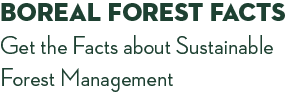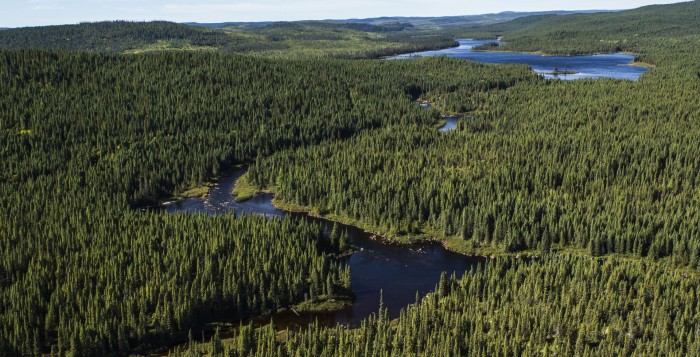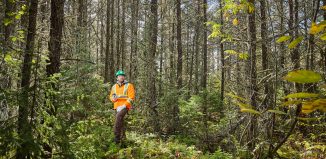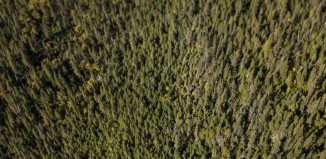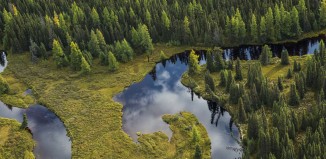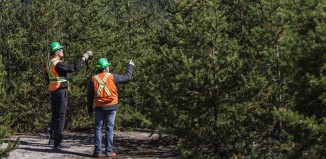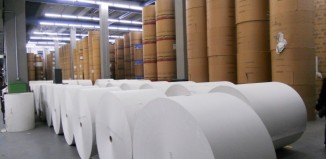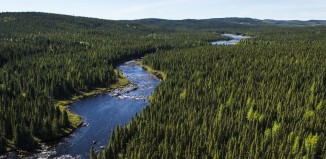Introducing Canada’s Boreal Region
Canada’s boreal region covers almost 60 percent of the country’s land area, essentially spanning from the Atlantic to the Pacific. At 2,000,000 mi², (over 5,740,000 km²), it is one of the largest and most complex ecosystems on the planet.
The boreal forest is fantastically diverse and complex. An ecosystem of lakes and wetlands moderates the climate, produces oxygen and purifies the water supply for its inhabitants. Much of the world’s freshwater is in the boreal’s lakes, rivers and streams. More than 208 billion tons of carbon are stored in the boreal’s trees, soils, water and peat, meaning that the forest has a significant impact on the planet’s ability to regulate the levels of carbon in the atmosphere.
According to Natural Resources Canada, “Canada’s boreal forest is often portrayed as one vast tract of ancient, pristine wilderness but this isn’t the case. Although the boreal region itself is ancient, the boreal forest is made up mostly of trees that are relatively young compared with many that grow in more temperate climates. It is regularly affected by forest fires, insects and other natural disturbances, but continually renews itself through these natural disturbances.”
Canadian Boreal Species
- The Canadian boreal is home to a rich variety of tree species including Balsam Fir, White Birch, Poplar, Black and White Spruce, Jack Pine, Red Pine and Eastern White Cedar.
- The region is home to more than just millions of acres of trees and wetlands — thousands of species of animals, birds, plants and insects thrive in its habitat.
- Millions of land birds call the boreal region home, either permanently or as seasonal migrants. Among other species, the boreal is home to owls, hummingbirds, woodpeckers, vultures, hawks, kingfishers and songbirds.
- Large mammal species in the Canadian boreal include caribou, deer, moose, wolves, and black bears.
- Countless smaller mammals also call the boreal home, including foxes, lynx, raccoons, porcupines, hares, beavers, ermines, muskrats, pine marten, squirrels and bats.
- Then there are the boreal’s insects, which include beetles, dragonflies, grasshoppers, bees, ants and—if you’ve had the chance to see them in person – spectacular butterflies.
Sustaining Whole Communities: Economic Impact of the Boreal
- The forest products industry has been an important part of the Canadian economy for generations, and Aboriginal communities have relied on the boreal for millennia.
- The forest products industry has a unique responsibility to understand and protect the forest and to study how best to ensure its viability as a source for natural, economic and social development.
- The forest products industry has an outsized impact on the livelihoods and wellbeing of many Canadian communities. More than 600 Canadian communities rely on forestry. Half of those depend on forestry for at least 50% of household income, and about 160 of those communities are solely reliant on forestry.
- 70% of Aboriginal communities in Canada are located in forested regions.
- There are about 17,000 First Nations people working in Canada’s forest products sector and the sector’s activities involve more than 1,400 Aboriginal businesses.
- Canada’s forest products industry is a $67 billion dollar (CAD) a year industry.
- Canada’s forest products industry provides 230,000 direct jobs and almost 1 million indirect jobs across the country.
- Our industry pays wages that are, on average, 16 percent above the national average, which helps sustain the economic health of hundreds of villages, towns and cities.
- The products we produce are an important link between the United States and Canada, as the U.S. is by far the largest importer of Canadian forest products – used to produce products like newspapers, magazines, books, printing and writing papers, tissues and building materials.
The boreal forest is one of the great wonders of the natural world. It spans much of the Northern Hemisphere, from North America and Asia to parts of Europe, and is considered public land. The forest is home to unique plants, animals and human cultures that have coexisted for thousands of years. Those of us who live and work in Canada’s boreal region consider it a critical part of our culture, economy and collective future.
